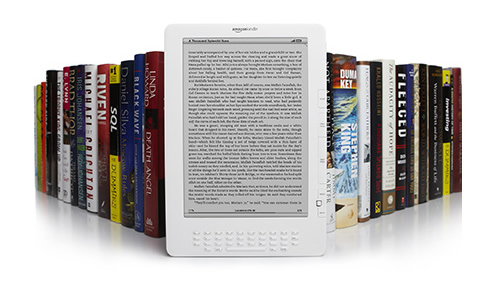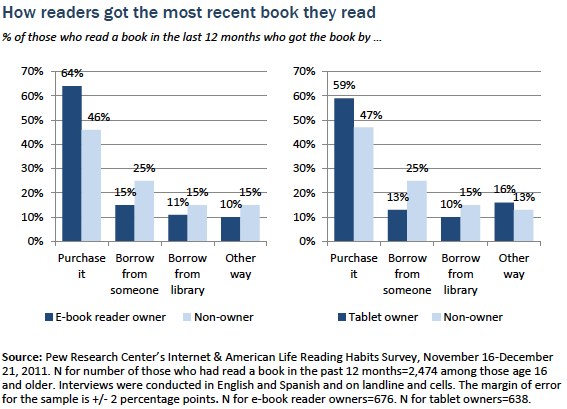Publishing In Today’s Digital, Social Reading Environment
Reading. It’s a fundamentally solitary pastime that’s becoming increasingly more social given the baked-in functionalities of e-reading devices (Tweet this!). It’s also – surprise! – an activity on the upswing for a couple of reasons: a proliferation of e-reading devices that are plummeting in price, and consumers’ broad acceptance of reading content on phones and […]
Reading. It’s a fundamentally solitary pastime that’s becoming increasingly more social given the baked-in functionalities of e-reading devices (Tweet this!).
It’s also – surprise! – an activity on the upswing for a couple of reasons: a proliferation of e-reading devices that are plummeting in price, and consumers’ broad acceptance of reading content on phones and computers (not necessarily on Kindles and Nooks), as a new e-reading study from the Pew Internet and American Life Project reveals.
Let’s look at some of the findings from The Rise of e-Reading, then indulge in a bit of speculation about where all this digital content consumption might be headed.
Pew found that consumers who read on digital devices not only read more stuff (not just books, but magazines and other long-form content), but they also buy significantly more reading material. This cohort is growing in numbers at an astonishing rate.
E-reading Hypergrowth
More than 21 percent of Americans say they’ve read a book in electronic form during the past year. As recently as last December, it was only 17 percent. Nearly 3 in 10 adult Americans now own at least one device designed for electronic reading — either an e-reader such as the Kindle or a tablet.
Bump e-reading up to include phone and computers and nearly half of American over 16 (43 percent) are reading books, magazines, journals, and news articles electronically.
The fraction of people who owned an e-reader, and the fraction who owned a tablet, both nearly doubled over the recent holiday season, from 10 percent in December to 19 percent in January. It can’t be a coincidence that this growth spurt corresponds with Amazon introducing a Kindle for under $80.
E-book readers say they’re both reading more, and buying more to read. They consumed an average of 24 books during the past 12 months, compared with 15 books for non-electronic readers.
When it comes to how they acquire books (as opposed to other forms of content), 64 percent of ebook owners buy content, as opposed to only 46 percent of non-owners, who are more inclined to borrow books from a friend, family member or library.
Where’s This Headed?
More reading, more book buying — these can never a bad thing. Yet one strongly suspects that all this additional reading isn’t strictly confined to books and periodicals. Marketers are taking note of this growing trend toward digital content. Catalogues have become a form of e-reading that not fully distinguished from glossy magazines in digital form – after all, both can be characterized as “lifestyle books.”
Catalogues and magazines — and increasingly books — are under pressure to capitalize on digital capabilities once they become digital. Just as periodicals have gone increasingly multimedia online (for example, movies, audio and slideshows on NYT.com), so will books.
Enhanced ebooks is already a big category in children’s publishing, as well as for books and other publications linked to entertainment propoerties (Harry Potter, anyone?). Magazines and catalogues have followed suit, and as publishing migrates from the digital version of black and white (older e-readers) to color and tablets with more functionality and connectivity, just-plain-text will be too plain for many “readers” in many contexts.
As publishers grapple with the multimedia issues inherent in digital publishing, they can’t ignore the social aspects either. “Tweet this” has been baked into the Kindle for several versions now, but shareable content will become deeper, richer and broader, as well as span more social networks. Readers won’t just share passages from books, but illustrations, charts, and rich content such as movies and animations.
All this raises some interesting questions, such as what a book really is, anyway. Once the domain of publishers, publishing is now open to marketers — and pretty much anyone else. Once pretty much limited to text and perhaps some photos and illustrations, “books” and “magazines” will soon, in large part, become indistinguishable from the richest of websites, both in terms of multimedia content, and “readers’” ability to share that content.
Contributing authors are invited to create content for MarTech and are chosen for their expertise and contribution to the martech community. Our contributors work under the oversight of the editorial staff and contributions are checked for quality and relevance to our readers. The opinions they express are their own.
Related stories
New on MarTech

